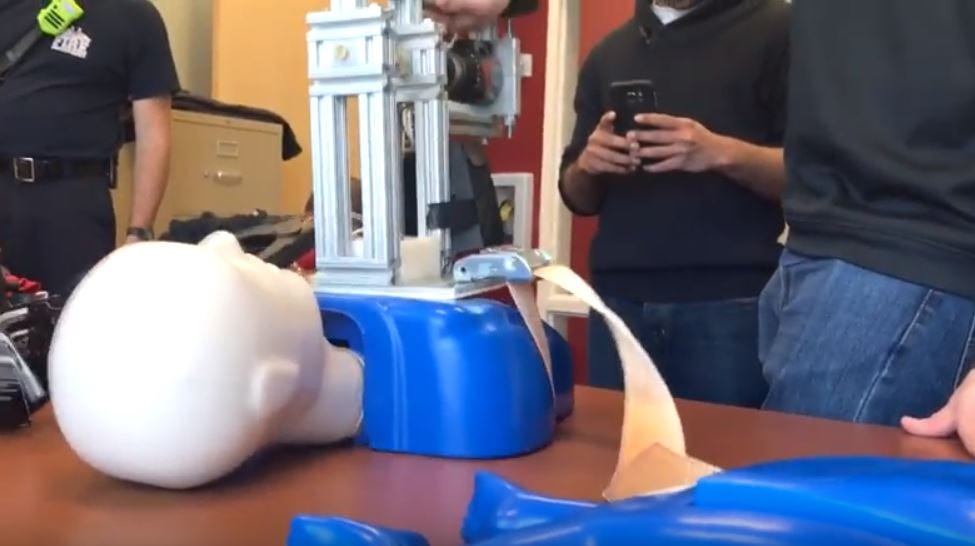Students Build AutoCPR Device for Disasters
 The teams says the lightweight device can deliver 150 pounds of force during patient chest compressions.
The teams says the lightweight device can deliver 150 pounds of force during patient chest compressions.
Subscriber Benefit
As a subscriber you can listen to articles at work, in the car, or while you work out. Subscribe NowWhen a deadly 7.8 magnitude earthquake rocked his home country of Ecuador in 2016 and killed more than 650 people, Purdue University alumnus Dr. Jorge Alfredo Uquillas was distraught by the number of deaths he says could’ve been prevented. Now a professor at an Ecuadorian medical school, he says patients couldn’t receive lifesaving CPR due to severe shortages of medical staff and long transit times to medical centers during the disaster. Uquillas turned to his alma mater and a team of Purdue students to help solve the problem. The “hands-free” AutoCPR device they invented recently captured a major award and is now being finalized for the field.
This month, the team of four students won the top prize in the 2017 Design Competition for Engineering World Health, a U.S. nonprofit that aims to improve health care delivery in low-resource countries. Uquillas told the team, during the disaster, patients had long transit times from the wreckage to a medical center—all of which are understaffed.
While there are automated devices commercially available, they can cost between $15,000 and $20,000. Uquillas, who earned his PhD in biomedical engineering at Purdue, asked a team of students studying the same subject to create an automated, low-cost, portable device that could deliver CPR.
Undergraduates Shadman Jubaer, Michael Dziekan, Vicki Sell and Sudhanshu Manda built the AutoCPR device for their senior design project. The small piece of machinery can be strapped to a person’s chest within 30 seconds, and a 12-volt battery—a typical car battery—can deliver 150 pounds of force during patient chest compressions.
“[An electrical motor] is attached to a crank, and that crank converts rotational motion into a linear motion and a linear force,” says Dziekan, now a mechanical engineering graduate student. “We take that linear force and use it to deliver chest compressions, about 100 to 120 per minute.”
The team believes the device would cost about $540, significantly lower than commercially-available devices. Dziekan says designing such an inexpensive but powerful piece of equipment was the most challenging aspect of the project.
“We were trying to make something that has the same efficacy as a commercial one, but for one-tenth of the cost,” says Dziekan. “There were some things we needed to really simplify.”
While the device was created with disasters in mind, Uquillas believes it could be meaningful in any developing country; in Ecuador, for example, Uquillas says a single medical center—typically under-staffed and under-equipped—usually serves about 2,500 people. He notes patients in rural areas require a 45-minute transit to a hospital.
While developing the device, the team realized it could also be useful in the U.S. The American Heart Association says nearly 90 percent of people who suffer out-of-hospital cardiac arrests die, and that CPR, especially if performed in the first few minutes of cardiac arrest, can double or triple a person’s chance of survival. Even in the best-case scenarios, rescuer fatigue inhibits CPR performance; chest compression quality declines significantly within three minutes.
Dziekan says the students consulted with the West Lafayette fire department during the development stages and learned it had to secure a grant to purchase the automated CPR device it uses.
“So even in the U.S., these devices are somewhat unaffordable. When we showed them our device, they loved the fact that it was simplistic, low-cost and it was very intuitive to use,” says Dziekan. “When they were setting up this other device, it took them a few minutes. With ours, you basically flip a switch, tune the power requirement and it’s ready to go.”
The team created the working prototype during the 2016-2017 school year. A second team of Purdue students is now fine-tuning the AutoCPR device, adding safety features and a pulse oximeter that can be placed on the neck to measure the blood’s oxygen level; this is the common device placed on a patient’s finger during routine doctor visits. After finalizing the device this semester, the team plans to send it to Ecuador for testing at the university medical center where Uquillas is a professor.
“It’s always nice when other people see value in something you’ve worked on for countless hours,” says Dziekan. “Hopefully, more people could be saved in the U.S. or Ecuador—or anywhere—with a device like this.”
Dziekan says ensuring the device is reliable is a top priority for the team.
Dziekan says a second team is working on additional features to ready the Auto CPR device for testing in Ecuador.
